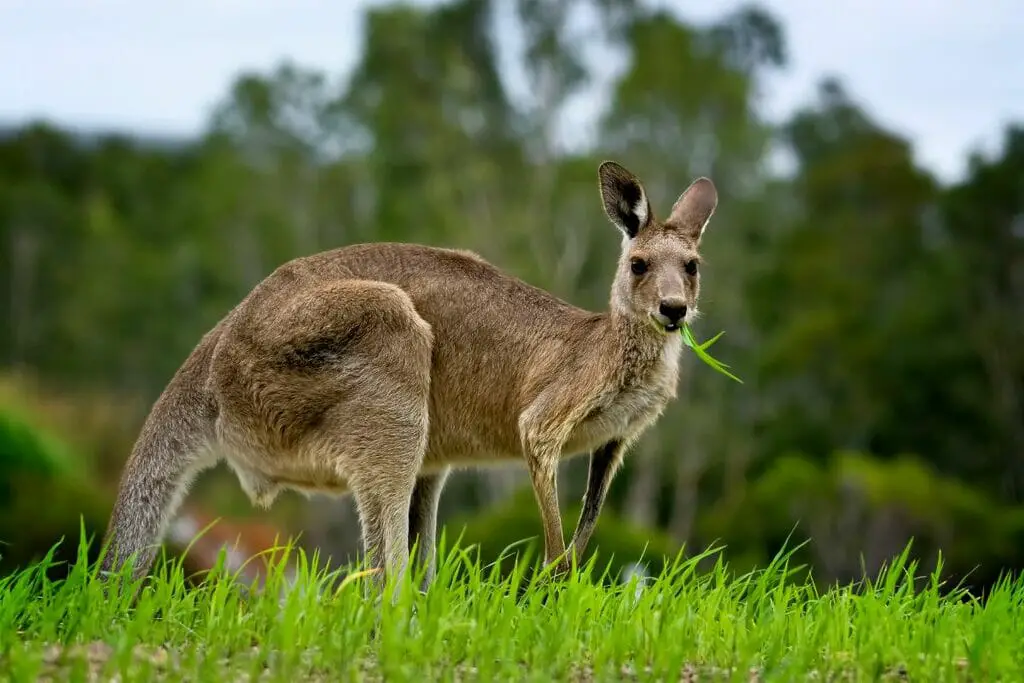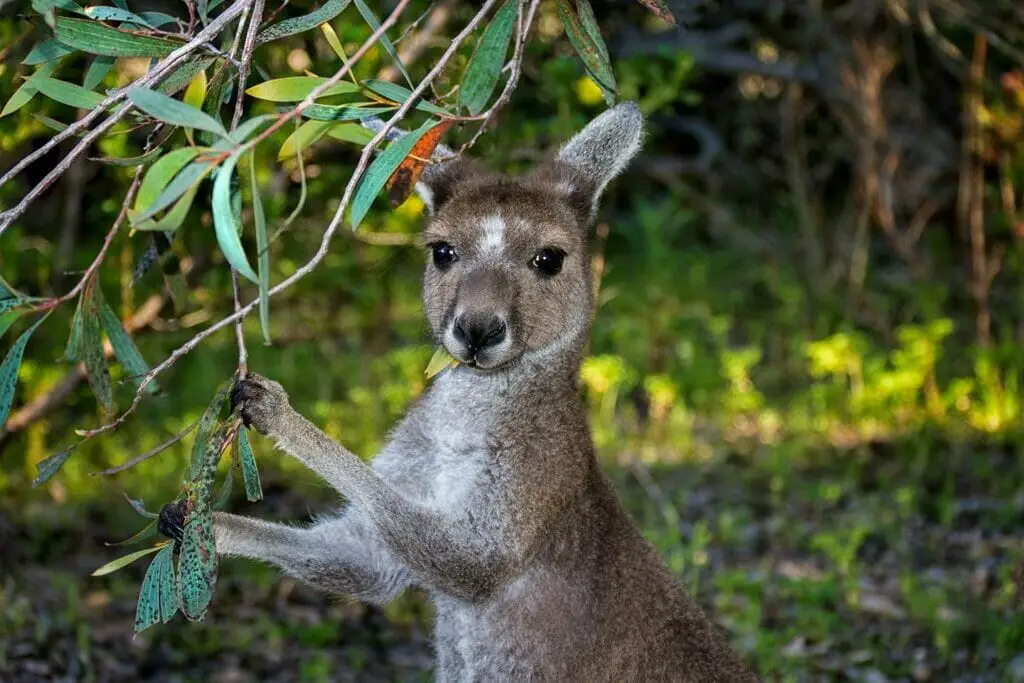Kangaroos are a much loved member of the marsupial family, and remain popular throughout Australia, and the world at large – thanks in part to their cute persona, unique physical appearance, and their springy movements.

But what exactly does a kangaroo eat, and how do they get the nutrients they need?
What Do Kangaroos Eat?
Most species of kangaroos consume strictly herbivorous diets, although there are variations between the species when it comes to the different types of plant matter being eaten.
The Eastern Gray Kangaroo
The Eastern Gray Kangaroo is a predominant grazer, meaning that it constantly eats small amounts of food throughout the waking hours, as opposed to consuming larger meals in one go.
The diet of the Eastern Gray tends to consist of the long, dry grasses of native to its home, although it has also been known to consume various other types of grass, depending on what is available.
The Red Kangaroo
On the other hand, the Red Kangaroo is known to consume small shrubs in their diet, the types of which are numerous and dependent on what is available and suitable at the time.
They too are grazers, and consume small amounts of food at regular intervals throughout the day.
Smaller Kangaroos
Smaller species of kangaroos have also been known to consume some species of fungus, such as various forms of hypogeal fungi – that is, types of fungus that live predominantly beneath the earth.
What Is The Eating Pattern Of Kangaroos?
Many species of kangaroos are nocturnal, and spend the hottest part of the day resting or sleeping in the shade of their burrows.
This means that their eating patterns are different to those of other animals, in that they tend to rest or sleep during the hotter parts of the day and afternoon, and then scavenge for food during the cooler mornings, evenings, and nights when the weather is more bearable.
Kangaroo Digestive Systems
Kangaroos have similar stomachs to some forms of cattle – like sheep and cows – in that they possess a single chambered stomach consisting of four compartments.
Because of this, many of their eating behaviors are similar to those of cattle, including the regurgitation of plant matter, which is then chewed as cud, before being properly digested afterwards.
However, unlike cows and sheep, they do not produce a lot of methane. Cows and sheep are known to produce large quantities through exhaling and eructation (burping), but kangaroos lack this methane release function.
Instead, the hydrogen created through the fermentation of plant matter is converted to acetate, which can then be used as a further source of energy for the kangaroos – something that is incredibly useful in the hot, physically demanding environment they are native to.
Do Some Kangaroos Eat Meat?
While all species of ground swelling kangaroos are strictly herbivores – or more specifically folivores, feeding on heavy leaf based diets – some tree dwelling species have been known to eat everything that a tree produces.
This makes their diet more that of an omnivore, seeing them consume bark, leaves, flowers, blossoms, seeds, and even things like bird eggs, bird hatchlings, and other small tree dwelling animals and insects that might be present at any one time.
This is an evolutionary necessity, as the amount of suitable vegetation in a tree is limited, making it necessary for them to find nutrients and food sources by other means.
What Do Baby Kangaroos Eat?

Baby kangaroos – also known as ‘Joeys’ – generally feed on the milk of their mother, depending on their age.
Kangaroo offspring develop extremely early in the gestation period, usually developing their front legs first, to allow them to climb up the pouch and latch onto their mothers nipples for feeding.
This period of suckling on milk usually lasts for nine months (minimum), after which they are able to properly leave the mother’s pouch on their own.
When the Joey is older however have also been known to eat a substance called ‘pap’ – a liquified form of the mother’s feces, which despite sounding disgusting, is actually laden with all the basic nutrients that the growing baby needs.
Does the Environment Affect Their Diet?
The environment in which the kangaroo lives does have a great impact on the diet they consume.
In Trees
As mentioned above, some species of kangaroos – namely tree dwelling species – are known to consume small amounts of meat in the form of hatchlings, eggs, and insects, for no other reason than they are what is available in their habitat.
On The Ground
Ground dwelling kangaroos have varied plant based diets, generally consisting of whatever is prominent and available at the time – however it usually consists of grasses, leaves, and some forms of shrub and fungus.
Urban Kangaroos
Kangaroos that live close to urban and suburban areas have been known to vary their diets somewhat, and are a common sight in the gardens of residents in these areas.
Kangaroos have been known to scavenge and consume fruit from people’s gardens, as well as vegetables and types of flowers like roses.
In Captivity
Kangaroos that live in zoos and animal sanctuaries also have slight variations to their diets, usually in the form of alfalfa hay, carrots, lettuce, broccoli, bananas, grapes, apples, romaine and dandelion leaves, corn, raisins, sweet potatoes, as well as specially formulated pellets laden with extra nutrients and vitamins.
What Won’t Kangaroos Eat?
However, there are some forms of vegetation that kangaroos are not fond of. This mainly consists of aromatic plants like rosemary, lavender, and the native eucalyptus.
Final Thoughts
And there we have it, everything you need to know about the diet of the kangaroo, and the variations therein.
While most kangaroos observe a herbivorous diet, there are some species which have to alter their behavior due to necessity – something that would otherwise make their survival impossible in the harsh, demanding environment within which they live.









